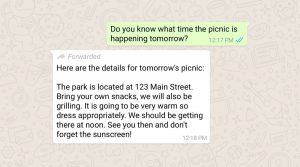Meta goes to NCLAT against CCI’s Rs 213 crore penalty on WhatsApp
Meta has now informed the NCLAT that the CCI order has wide ramifications for the industry as a whole and therefore, an urgent hearing in the matter will be required.
Asked by the government to act after recent spate of killings over rumours spread through the platform, WhatsApp says it has started an education campaign on how to spot fake news and rumours

On 10 July, WhatsApp published a full-page advertisement in some newspapers as part of its new campaign to fight misinformation and fake news. (Photo: AFP)
From Tuesday night (10 July) onwards, the WhatsApp messenger application on your phone will have a new feature. Every WhatsApp message you get will tell you if it’s an original post sent by your contact or just a forward.
The messaging app owned by Facebook says it will from now onwards indicate which messages you receive have been forwarded to you and not created by the sender.
Advertisement
“This extra context will help make one-on-one and group chats easier to follow. It also helps you determine if your friend or relative wrote the message they sent or if it originally came from someone else,” says a WhatsApp statement.
Advertisement
READ | In full-page ad, WhatsApp urges users in India to fight fake news
To activate this feature, however, you need to have the latest supported version of WhatsApp on your phone.
“WhatsApp cares deeply about your safety. We encourage you to think before sharing messages that were forwarded. As a reminder, you can report spam or block a contact in one tap and can always reach out to WhatsApp directly for help,” says the company.

Mob lynchings have left at least 27 people dead across nine states in the last one year. After a spate of killings in the last three months, the Government of India recently asked the messaging app to act urgently to stop the spread of “irresponsible and explosive messages” on its platform.
READ | WhatsApp ‘horrified’ at lynchings, lists measures taken
The killings in the last one year have been reported from Maharashtra, Assam, Tripura, West Bengal, Telangana, Karnataka, Tamil Nadu, Jharkhand and Chattisgarh.
Behind all the fatal attacks were rumours of child kidnappings spread through WhatsApp Message s. The police had said they were finding it hard to convince people that the messages were false. In fact, one of the lynching victims in Tripura was a man who had been hired as an announcer by the state authorities to dispel rumours about child-lifters.
In its reply to the Union Ministry of Information and Technology, WhatsApp had said it was “horrified by these terrible acts of violence”, and called the situation a “challenge that requires government, civil society and technology companies to work together”.
READ | WhatsApp launches research awards to fight misinformation, fake news
On Tuesday, WhatsApp published a full-page advertisement in some newspapers as part of its new campaign to fight misinformation and fake news.
In the advertisement, the messaging app listed 10 points for its users to go through to tackle misinformation.
“We are starting an education campaign in India on how to spot fake news and rumours. Our first step is placing newspaper advertisements in English and Hindi and several other languages. We will build on these efforts,” it said.
The new feature to be rolled out from 11 July, which will allow users to know when a message is just a forward and not an original post, is part of this campaign.
Advertisement